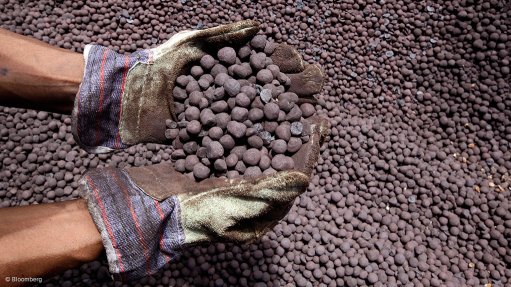Gold moving into balance, perhaps even deficit – World Gold Council
JOHANNESBURG (miningweekly.com) – The gold market appeared to be moving back towards a balance and even a deficit quite quickly, World Gold Council (WGC) MD investment strategy Marcus Grubb said on Tuesday.
Gold hit a three-and-a-half-month peak on Monday as fear over US economic growth and a weaker dollar added to the metals’ safe-haven appeal, extending its gains after rising the most in six months last week.
Grubb told Mining Weekly Online that he expected to see a much better year for gold this year than in 2013, when demand got the precious metal totalled 3 756.1 t, worth $170-billion, down 15% on 2012.
“The gold market is bottoming out here,” he said, adding that the move of gold from the West to East had happened with the big move of exchange-traded fund (ETF) tonnage to satisfy mainly Asian consumer demand.
Some 880 t of gold – or 28-million ounces on top of recycling and mine production – flowed out of ETFs into the market in 2013, which was probably four to five times the yearly output of the largest gold miner.
With ETFs already turning positive, that was unlikely to be repeated.
“We think this market is moving back towards a balance and even a deficit quite quickly,” Grubb added to Mining Weekly Online.
Investors who had reduced their gold in the first six weeks of this year on the basis of a lack of perceived risk had already been put on the spot.
On the demand side, both investment and consumer demand were expected to remain at 2013 levels, while on the supply side, little change was expected.
Recycling, which dropped 14% last year, might even drop again in 2014, and mine production was unlikely to rise.
Emerging-market central banks were indicating that they wanted to buy more gold and were on the bid in the current market.
Overall, the WGC expected central banks and especially the emerging-market banks, to continue to be buyers of probably similar amounts in 2014 as in 2013, although no formal targets had been set yet.
The council expected the buying trend of the central banks to remain intact, albeit at a more moderate pace.
The 368.6 t bought in 2013 represented the four consecutive year of central bank buying and a fifth buying year was expected.
An eye would, however, be kept on the central bank gold agreement, which was up for renewal when it ended in September.
Gold demand remained strong in China, exemplified by an unexpected 29 t delivery in one day on the Shanghai Gold Exchange last week, well after the end of the New Year celebration.
With the Indian current account deficit much improved and elections in May, it was hoped that India would lift its restriction on gold sales.
Stronger economic numbers out of the US as the effect of the cold winter wore off might induce futures-market bears to push back on gold.
Economic growth in the US was benefitting jewellery demand and the announced intention to keep interest rates low was bullish for gold.
WGC initiatives under way to add impetus to the jewellery demand included the LoveGold brand, in the US, and renewed investment into the Azva jewellery line launched in India.
GOLD DEMAND TRENDS
Gold’s 2013 party was spoilt by ETF outflow and lower central bank buying, which outweighed record-high demand for gold bars and coins, and gold jewellery sales at close to pre-crisis levels.
The council’s 2013 Gold Demand Trends just released shows that the flow of gold from western vaults to eastern markets, through refiners in North America, Switzerland and Dubai, reached unprecedented levels in 2013 when Chinese gold consumers set a new yearly record and Indian consumers did well to hurdle import restrictions.
Gold supply fell 2% for the second year running, the decline in recycling more than nullifying the slight increase in mine production.
The average 2013 gold price in dollar, euro, pound and renminbi currencies was 16% lower than in 2012.
Consumers generated 21% more demand for jewellery, small bars and coins, taking consumption to a record.
The voracious appetite for physical metal among consumers in India, China and numerous Asian and Middle Eastern markets saw the transformation – on an epic scale – of 400 oz London Good Delivery bars into smaller denominations more suitable for consumers’ pockets.
Three-quarters of the 880.8 t ETF outflow was absorbed by growth in annual consumer demand of 678.4 t, the largest year-on-year increase since the WGC’s records began and a demonstration of the strength of physical demand for jewellery, bars and coins.
Indian demand of 974.8 t was the third highest yearly volume, despite the introduction by the Indian government of higher import duties, strict import quotas and restrictions on gold-related lending and coin sales in an attempt to reduce the country’s current account deficit.
After dropping sharply in line with the international gold price in April, the Indian rupee price of gold soon decoupled from the dollar price owing to a combination of local currency weakness and demand/supply pressure.
As supply restrictions took hold, premiums were pushed up, inflating already high local prices compared with the international price.
As a result, Indian consumers missed the opportunity to buy gold at lower levels during the second half of the year, unlike consumers in many other markets.
Q4 saw a sixth consecutive quarter of year-on-year gold jewellery growth with demand of 553.8 t, 12% above the five-year quarterly average, and the demand for bars and coins surged to an all-time high of 1 654.1 t.
Of the 368.6 t bought by central banks in 2013, Russia bought 77 t, Kazakhstan 28 t, Azerbaijan 20 t and Korea 20 t.
The volume of gold used in technology fell slightly to 404.8 t in 2013 from 407.5 t in 2012.
Comments
Press Office
Announcements
What's On
Subscribe to improve your user experience...
Option 1 (equivalent of R125 a month):
Receive a weekly copy of Creamer Media's Engineering News & Mining Weekly magazine
(print copy for those in South Africa and e-magazine for those outside of South Africa)
Receive daily email newsletters
Access to full search results
Access archive of magazine back copies
Access to Projects in Progress
Access to ONE Research Report of your choice in PDF format
Option 2 (equivalent of R375 a month):
All benefits from Option 1
PLUS
Access to Creamer Media's Research Channel Africa for ALL Research Reports, in PDF format, on various industrial and mining sectors
including Electricity; Water; Energy Transition; Hydrogen; Roads, Rail and Ports; Coal; Gold; Platinum; Battery Metals; etc.
Already a subscriber?
Forgotten your password?
Receive weekly copy of Creamer Media's Engineering News & Mining Weekly magazine (print copy for those in South Africa and e-magazine for those outside of South Africa)
➕
Recieve daily email newsletters
➕
Access to full search results
➕
Access archive of magazine back copies
➕
Access to Projects in Progress
➕
Access to ONE Research Report of your choice in PDF format
RESEARCH CHANNEL AFRICA
R4500 (equivalent of R375 a month)
SUBSCRIBEAll benefits from Option 1
➕
Access to Creamer Media's Research Channel Africa for ALL Research Reports on various industrial and mining sectors, in PDF format, including on:
Electricity
➕
Water
➕
Energy Transition
➕
Hydrogen
➕
Roads, Rail and Ports
➕
Coal
➕
Gold
➕
Platinum
➕
Battery Metals
➕
etc.
Receive all benefits from Option 1 or Option 2 delivered to numerous people at your company
➕
Multiple User names and Passwords for simultaneous log-ins
➕
Intranet integration access to all in your organisation





















